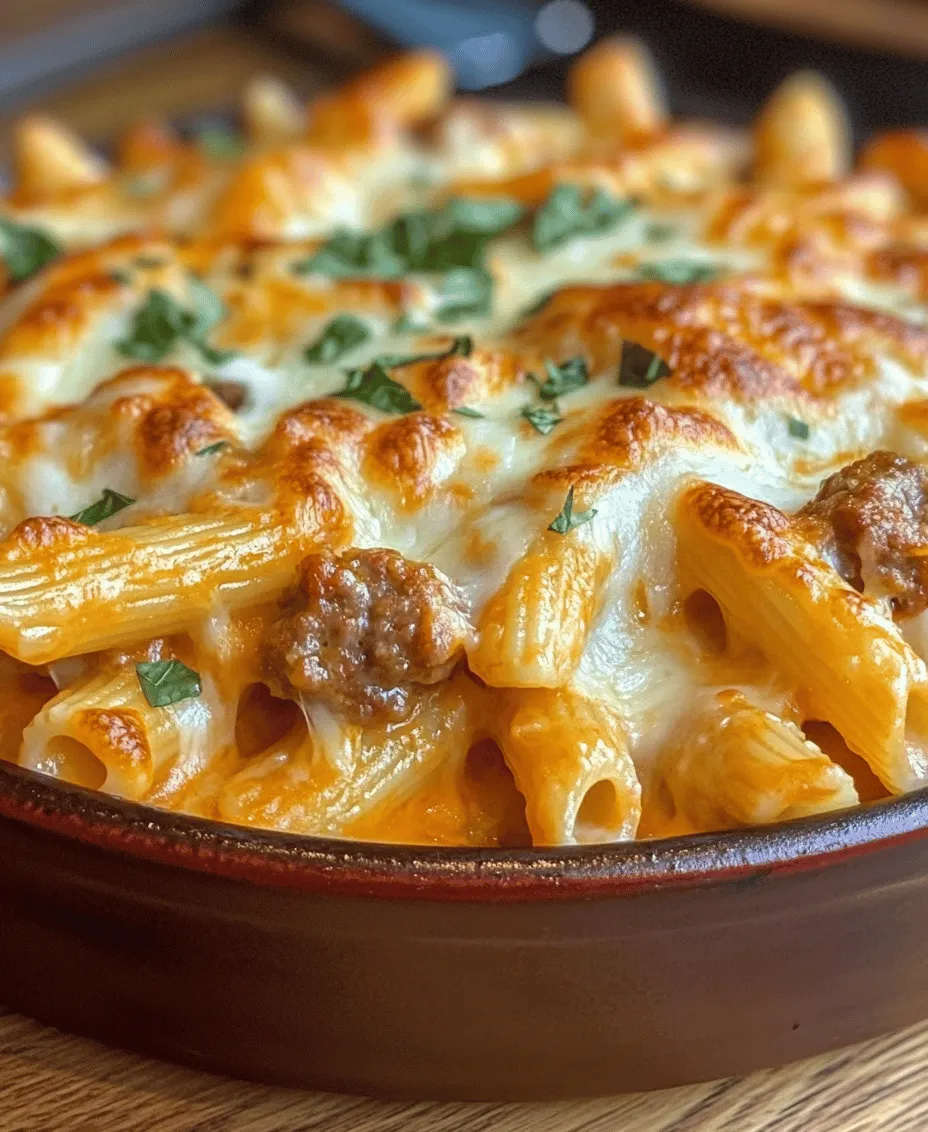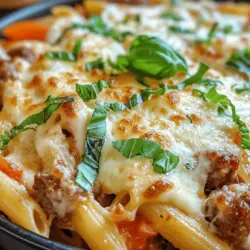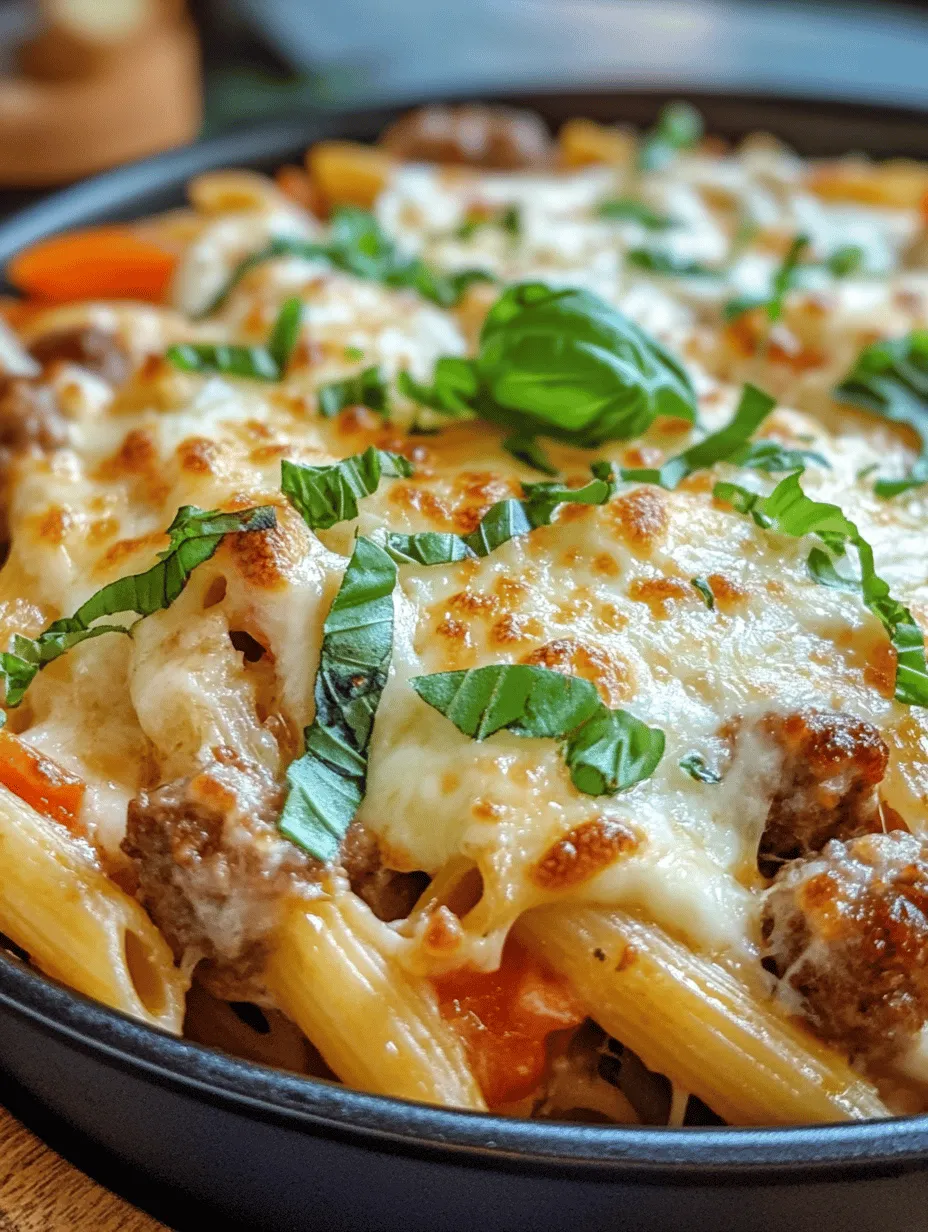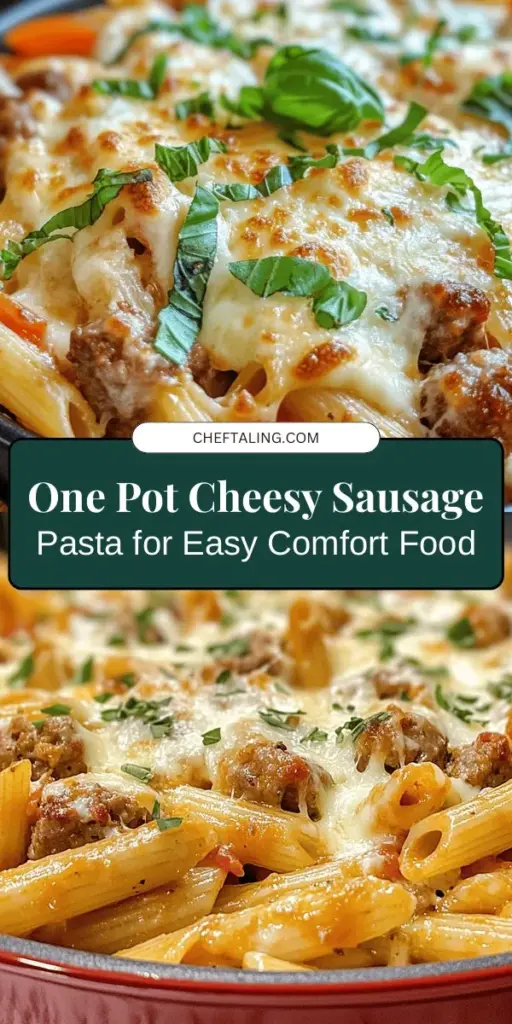In the realm of comfort food, few dishes can rival the hearty and satisfying flavors of One Pot Cheesy Sausage Pasta. This delightful recipe combines the richness of Italian sausage with the creaminess of melted cheese, all cooked together with tender penne pasta. Perfect for busy weeknights or a cozy family dinner, this dish is not only easy to prepare but also packs a flavorful punch. In this article, we will explore the ingredients, cooking process, and tips for enjoying this delicious meal, ensuring that you can recreate it in your own kitchen with ease.
Understanding the Ingredients
The Star of the Dish: Italian Sausage
At the heart of this delectable pasta dish is the Italian sausage, which brings a robust flavor that elevates the entire meal. When selecting your sausage, you’ll find a variety of options, typically categorized as mild or spicy. Mild Italian sausage is seasoned with a blend of spices such as fennel, garlic, and black pepper, offering a gentle flavor profile that complements the other ingredients without overwhelming them. On the other hand, spicy Italian sausage introduces a kick of heat, making it a perfect choice for those who enjoy a bit of zest in their dishes.
When choosing the right sausage for your One Pot Cheesy Sausage Pasta, consider your family’s taste preferences. The beauty of this recipe lies in its versatility; you can easily switch between mild and spicy sausage or even use a combination of both for a balanced flavor. Regardless of your choice, the Italian sausage serves as the foundation for a rich and savory sauce that coats every piece of pasta.
The Base: Penne Pasta
Penne pasta is the ideal base for this one-pot dish, thanks to its tubular shape and ridged surface. These characteristics allow the pasta to hold onto the creamy sauce and absorb the flavors of the dish beautifully. When cooking penne, it’s essential to achieve the perfect al dente texture, which means the pasta should be cooked until it’s firm to the bite, yet tender enough to enjoy.
To ensure your penne is cooked just right, consider the following tips:
1. Salt Your Water: Adding ample salt to your boiling water not only flavors the pasta but also enhances the overall dish.
2. Follow Package Instructions: Cooking times may vary based on the brand, so always refer to the package for guidance.
3. Stir Occasionally: This prevents the pasta from sticking together or to the pot, ensuring even cooking.
By using penne pasta in this recipe, you will achieve a satisfying texture that pairs well with the creamy cheese and savory sausage.
Aromatics and Vegetables
No hearty dish is complete without aromatics and vegetables, which play a vital role in flavor development. For this recipe, we incorporate onion, garlic, and red bell pepper, each contributing distinct tastes and aromas.
Onions provide a sweet and savory base, while garlic adds a pungent kick that enhances the overall flavor profile. Red bell pepper brings a hint of sweetness and vibrant color to the dish, making it visually appealing as well.
In addition to their flavors, these vegetables offer numerous nutritional benefits. Onions and garlic are known for their anti-inflammatory and immune-boosting properties, while red bell pepper is rich in vitamins A and C, contributing to a well-rounded meal.
The Liquid Gold: Chicken Broth
To create a rich and flavorful sauce, low-sodium chicken broth is a crucial ingredient in One Pot Cheesy Sausage Pasta. Using broth instead of water elevates the dish’s taste, allowing it to absorb the savory notes of the sausage and vegetables.
Opting for low-sodium chicken broth not only helps control the saltiness of the dish but also gives you the flexibility to season to your preference. The broth provides a depth of flavor and keeps the pasta moist while cooking, ensuring that every bite is packed with deliciousness.
The Magic of Tomatoes
Canned diced tomatoes play a significant role in this recipe, adding acidity and depth of flavor to the dish. Tomatoes not only enhance the overall taste but also contribute to the dish’s vibrant color and texture. They help to balance the richness of the cheese and sausage, creating a harmonious blend of flavors that is both comforting and satisfying.
When selecting canned tomatoes, look for high-quality brands that use ripe tomatoes, as this will impact the overall taste of your dish. The acidity from the tomatoes also helps brighten the flavors, making it an ideal complement to the creamy cheese and savory sausage.
Seasonings and Spices
To elevate the flavors of our One Pot Cheesy Sausage Pasta, a combination of Italian seasoning and red pepper flakes is used. Italian seasoning typically contains a blend of dried herbs such as oregano, basil, and thyme, which are quintessential to Italian cuisine. This seasoning not only adds complexity to the dish but also enhances the natural flavors of the sausage and vegetables.
For those who enjoy a bit of heat, red pepper flakes can be added to taste. This spice introduces a gentle warmth to the dish without overpowering the other flavors, making it a delightful choice for spice lovers.
The Creamy Finish: Cheese
No cheesy pasta dish is complete without the star ingredient: cheese. For this recipe, a combination of cheeses can be used to achieve a creamy, decadent finish. Common choices include shredded mozzarella, which melts beautifully and offers a mild flavor, and sharp cheddar, which adds a tangy kick to the dish.
When incorporating cheese, it’s essential to allow it to melt slowly into the sauce for the best texture. Stirring in the cheese towards the end of cooking ensures a creamy consistency that coats the pasta perfectly, transforming your dish into a comforting, cheesy delight.
Step-by-Step Cooking Instructions
Preparing the Sausage
The first step in creating your One Pot Cheesy Sausage Pasta is to prepare the sausage. Start by removing the casings from the sausage links if you’re using bulk sausage. If you prefer to use sausage links, simply slice them into bite-sized pieces.
In a large pot or Dutch oven, heat a drizzle of olive oil over medium heat. Once hot, add the sausage to the pot. Allow the sausage to cook, breaking it apart with a wooden spoon or spatula. Browning the sausage is crucial, as it develops a deep flavor that will permeate the entire dish. Aim for even cooking, ensuring that the sausage is browned on all sides. This process should take about 5-7 minutes.
Sautéing Vegetables for Maximum Flavor
Once the sausage is cooked through, it’s time to add the aromatics and vegetables. Start by adding diced onions to the pot, stirring them into the sausage. Sauté the onions for about 2-3 minutes until they become translucent and fragrant. Next, add minced garlic and diced red bell pepper, cooking for an additional 2-3 minutes.
The key to achieving the right texture in sautéed vegetables is to pay attention to cooking times. Onions should be softened but not browned, while bell peppers should retain some crunch for added texture. Stirring occasionally will help prevent any sticking or burning.
Combining Ingredients for One-Pot Cooking
After sautéing the vegetables, it’s time to combine all the ingredients to create your One Pot Cheesy Sausage Pasta. Begin by adding the penne pasta to the pot, followed by the canned diced tomatoes and low-sodium chicken broth. Be sure to scrape up any browned bits from the bottom of the pot, as this will enhance the flavor of your dish.
Next, incorporate your seasonings—Italian seasoning and red pepper flakes—stirring everything together until well combined. Bring the mixture to a gentle boil, then reduce the heat to low, covering the pot to allow the pasta to cook. This one-pot method ensures that the pasta absorbs all the flavors from the sausage, broth, and seasonings while cooking.
Continue cooking for about 10-12 minutes, or until the pasta is al dente and has absorbed most of the liquid. Be sure to stir occasionally to prevent sticking, and adjust the heat as needed to maintain a gentle simmer. Once the pasta reaches the desired texture, remove the pot from heat and stir in your cheese, allowing it to melt into a creamy sauce.
With these steps, you are well on your way to creating a delicious One Pot Cheesy Sausage Pasta that is sure to impress your family and friends. The combination of flavorful sausage, vibrant vegetables, and creamy cheese creates a meal that is both comforting and satisfying. Stay tuned for the next part of the article, where we will explore additional tips for achieving the best results and answer some common questions about this delightful recipe.

Tips for Ensuring Even Cooking and Flavor Distribution
To achieve optimal results when preparing One Pot Cheesy Sausage Pasta, it’s crucial to ensure that both the pasta and sausage are cooked evenly while allowing the flavors to meld beautifully. Here are some tips to help you do just that:
1. Sauté the Sausage Properly: Begin by browning the sausage evenly in the pot. This step not only adds flavor through the Maillard reaction but also helps render the fat, which will enhance the overall richness of your dish. Make sure to break the sausage into small pieces to promote even cooking.
2. Use the Right Broth-to-Pasta Ratio: The key to cooking pasta in broth is to use enough liquid to prevent it from becoming dry. A general rule of thumb is to use about 2 cups of broth for every 8 ounces of pasta. As the pasta absorbs the liquid, it will soak up all the flavors, resulting in a cohesive dish.
3. Stir Frequently: To prevent the pasta from sticking together and to ensure even cooking, stir the mixture every few minutes. This encourages the pasta to release its starches into the broth, creating a creamy sauce as it cooks.
4. Season Generously: Don’t be shy with the seasoning. Adding salt early in the cooking process helps to enhance the flavors of the pasta and sausage as they cook. Taste as you go to adjust the seasoning levels to your preference.
Cooking the Pasta to Perfection
Key Indicators to Watch for When Cooking Pasta in the Broth
Cooking pasta in broth is a simple yet effective method that allows the pasta to absorb maximum flavor. Here are a few indicators that your pasta is perfectly cooked:
- Al Dente Texture: Aim for an al dente texture—firm but not hard. This can typically be achieved by checking the pasta a couple of minutes before the package’s suggested cooking time.
- Liquid Absorption: Watch for the broth’s reduction; the pasta should not swim in excess liquid. If you notice too much liquid left, you can increase the heat slightly to help it evaporate.
- Starchiness: The water should become slightly thickened due to the starch released from the pasta. This thickness is essential for the creamy sauce that will envelop your dish.
How to Prevent Sticking and Ensure an Even Cook
To avoid pasta sticking together, consider the following techniques:
- Add a Splash of Oil: A small amount of olive oil added to the pot can help reduce sticking. However, be cautious not to overdo it, as it can also inhibit the sauce from adhering to the pasta.
- Use a Wide Pot: Cooking the pasta in a wide pot allows for better circulation of the liquid, which can help prevent sticking. It also promotes even cooking throughout.
- Avoid Overcrowding: If you are making a larger batch, consider cooking in smaller batches. Overcrowding the pot can lead to uneven cooking and sticking.
Adding Cheese for Creaminess
Explanation of When to Add Cheese During Cooking
The cheese is the star of the show when it comes to creating the creamy texture in this dish. You’ll want to add it toward the end of the cooking process:
1. After the Pasta is Cooked: Once you’ve achieved that perfect al dente pasta, reduce the heat to low and add your cheese. This allows it to melt gently without clumping.
2. Gradually Incorporate Cheese: Add the cheese in batches, stirring continuously. This method ensures that the cheese melts uniformly and combines with the sauce, creating a silky consistency.
Techniques to Achieve a Creamy, Cohesive Sauce
To ensure a creamy sauce that clings to every piece of pasta, follow these techniques:
- Use Grated Cheese: Grated cheese melts more easily than blocks, helping to create a smoother sauce. A combination of cheeses, such as mozzarella for stretch and Parmigiano-Reggiano for flavor, can elevate the dish.
- Reserve a Little Cooking Liquid: Before draining any excess broth, reserve a cup of the cooking liquid. This starchy water can be added to help achieve the desired creaminess if the sauce is too thick.
- Stir Vigorously: Use a wooden spoon or spatula to stir the pasta and cheese mixture vigorously. This movement helps to emulsify the fat from the cheese with the starchy pasta liquid, resulting in a creamy sauce.
Plating and Garnishing
Ideas for Presenting the Dish Attractively
Presentation plays a significant role in how a dish is perceived. For your One Pot Cheesy Sausage Pasta, consider the following plating ideas:
1. Use Shallow Bowls: Serve the pasta in shallow bowls to showcase its vibrant colors and textures. This style allows for a more elegant presentation.
2. Twirl the Pasta: Use a fork to twist a portion of the pasta into a neat mound. This technique adds height and visual interest to your plate.
3. Drizzle with Olive Oil: A light drizzle of high-quality olive oil before serving can add a glossy finish and enhance flavor.
The Role of Fresh Basil as a Garnish and Flavor Enhancer
Fresh basil is an essential garnish for this dish. Not only does it add a pop of color, but it also enhances the flavor profile:
- Chop and Sprinkle: Chop fresh basil leaves and sprinkle them generously over the plated pasta just before serving. The aromatic oils will release, providing a refreshing contrast to the richness of the cheese.
- Whole Leaves for Presentation: Alternatively, place a couple of whole leaves on top of the pasta for a more sophisticated look. This method highlights the freshness of the dish.
Nutritional Analysis
Breakdown of Nutritional Content
Understanding the nutritional content of your One Pot Cheesy Sausage Pasta can help you make informed dietary choices. Here’s an overview of the typical nutritional breakdown per serving:
- Calories: Approximately 500-600 calories, depending on the type of sausage and cheese used.
- Protein: Around 25-30 grams from the sausage and cheese, making it a good source of protein.
- Fats: Approximately 20-25 grams, primarily from the sausage and cheese.
- Carbohydrates: Roughly 60-70 grams, mainly from the pasta.
Health Benefits of the Ingredients Used in the Recipe
- Sausage: Provides high-quality protein and essential vitamins such as B12.
- Pasta: A good source of carbohydrates, perfect for energy, especially for those with an active lifestyle.
- Cheese: Offers calcium, which is vital for strong bones and teeth, along with beneficial fats.
- Vegetables (such as bell peppers or spinach): Adding vegetables can boost the fiber content and provide essential vitamins and minerals.
Dietary Considerations
Suggestions for Making the Dish Gluten-Free or Vegetarian
- Gluten-Free: Substitute regular pasta with gluten-free pasta made from brown rice or lentils. Ensure that the sausage used is also gluten-free.
- Vegetarian: Replace the sausage with plant-based alternatives, such as lentils, chickpeas, or a combination of mushrooms and spices to mimic the flavor and texture.
How to Modify the Recipe for Specific Dietary Needs
- Low-Carb: Use spiralized zucchini or spaghetti squash instead of traditional pasta for a low-carb option.
- Dairy-Free: Use a dairy-free cheese alternative or nutritional yeast to achieve a cheesy flavor without the dairy.
Variations and Customizations
Alternate Protein Options
If you’re looking to switch up the protein in your One Pot Cheesy Sausage Pasta, consider these alternatives:
- Chicken or Turkey: Lean ground chicken or turkey can be used for a lighter option. Season with spices to enhance flavor.
- Plant-Based Sausages: For a vegetarian or vegan approach, plant-based sausages are now widely available and can provide a similar taste and texture.
Vegetable Additions
Incorporating vegetables not only enhances the nutrition of your dish but also adds color and texture:
- Spinach or Kale: Stir in fresh spinach or kale just before serving for added nutrients and a vibrant green color.
- Bell Peppers or Zucchini: Sauté diced bell peppers or zucchini with the sausage for additional flavor and texture.
Exploring Different Cheeses
Experimenting with various cheeses can lead to delightful flavor discoveries:
- Gouda or Gruyere: These cheeses melt beautifully and add a rich, nutty flavor to the dish.
- Feta or Goat Cheese: Crumbled feta or goat cheese added just before serving can provide a tangy contrast to the creamy sauce.
Spice Level Adjustments
To modify the heat level of your dish, consider these options:
- Add Red Pepper Flakes: For a mild kick, sprinkle red pepper flakes while sautéing the sausage.
- Hot Sausage: Use spicy sausage instead of mild for a more pronounced heat.
Storage and Reheating
Best Practices for Storing Leftovers
Leftovers of your One Pot Cheesy Sausage Pasta can be stored effectively to maintain quality:
- Refrigeration: Allow the pasta to cool before transferring it to an airtight container. It can be stored in the refrigerator for up to 3 days.
- Freezing: For longer storage, freeze the pasta in a freezer-safe container. It can last up to 2 months. To prevent freezer burn, ensure the container is tightly sealed.
How to Maintain Flavor and Texture During Storage
When storing, keep the following in mind:
- Avoid Overcooking: Under-cook the pasta slightly if you plan to reheat later. This prevents it from becoming mushy.
- Separate Sauces: If possible, store the pasta and sauce separately to maintain texture.
Reheating Methods
To enjoy your One Pot Cheesy Sausage Pasta without losing its quality, follow these reheating methods:
- Stovetop: Reheat in a skillet over low heat, adding a splash of broth or water to loosen the sauce. Stir frequently until heated through.
- Microwave: Place the pasta in a microwave-safe dish, cover it with a damp paper towel, and microwave in short bursts, stirring in between, until heated.
Conclusion
One Pot Cheesy Sausage Pasta is a quintessential dish that brings together comfort and flavor in an easy-to-make recipe. With its harmonious blend of ingredients and straightforward cooking process, it’s perfect for both novice cooks and seasoned chefs alike. Whether enjoyed on a busy weeknight or served at a gathering, this dish is sure to please. By understanding the ingredients and following the step-by-step instructions, anyone can create this delicious meal that warms the heart and satisfies the palate. So gather your ingredients, embrace the one-pot cooking style, and savor every bite of this delightful pasta dish!


